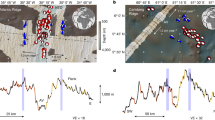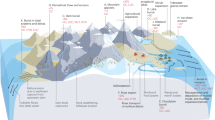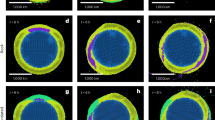Abstract
The balance between the subduction of carbonate mineral-bearing rocks into Earth’s mantle and the return of CO2 to the atmosphere by volcanic and metamorphic degassing1,2,3,4 is critical to the carbon cycle. Carbon is thought to be released from subducted rocks mostly by simple devolatilization reactions5,6,7. However, these reactions will also retain large amounts of carbon within the subducting slab and have difficulty in accounting for the mass of CO2 emitted from volcanic arcs. Carbon release may therefore occur via fluid-induced dissolution of calcium carbonate8,9,10. Here we use carbonate δ18O and δ13C systematics, combined with analyses of rock and fluid inclusion mineralogy and geochemistry, to investigate the alteration of the exhumed Eocene Cycladic subduction complex on the Syros and Tinos islands, Greece. We find that in marble rocks adjacent to two fluid conduits that were active during subduction, the abundance of calcium carbonate drastically decreases approaching the conduits, whereas silicate minerals increase. Up to 60–90% of the CO2 was released from the rocks—far greater than expected via simple devolatilization reactions. The δ18O of the carbonate minerals is 5–10 lighter than is typical for metamorphosed carbonate rocks, implying that isotopically light oxygen was transported by fluid infiltration from the surroundings. We suggest that fluid-mediated carbonate mineral removal, accompanied by silicate mineral precipitation, provides a mechanism for the release of enormous amounts of CO2 from subduction zones.
This is a preview of subscription content, access via your institution
Access options
Subscribe to this journal
Receive 12 print issues and online access
$259.00 per year
only $21.58 per issue
Buy this article
- Purchase on Springer Link
- Instant access to full article PDF
Prices may be subject to local taxes which are calculated during checkout




Similar content being viewed by others
References
Marty, B. & Tolstikhin, I. N. CO2 fluxes from mid-ocean ridges, arcs and plumes. Chem. Geol. 145, 233–248 (1998).
Hayes, J. M. & Waldbauer, J. R. The carbon cycle and associated redox processes through time. Phil. Trans. R. Soc. B 361, 931–950 (2006).
Dasgupta, R. & Hirschmann, M. M. The deep carbon cycle and melting in Earth’s interior. Earth Planet. Sci. Lett. 298, 1–13 (2010).
Burton, M. R., Sawyer, G. M. & Granieri, D. Deep carbon emissions from volcanoes. Rev. Mineral. Geochem. 75, 323–354 (2013).
Kerrick, D. M. & Connolly, J. A. D. Metamorphic devolatilization of subducted marine sediments and the transport of volatiles into the Earth’s mantle. Nature 411, 293–296 (2001).
Gorman, P. J., Kerrick, D. M. & Connolly, J. A. D. Modeling open system metamorphic decarbonation of subducting slabs. Geochem. Geophys. Geosyst. 7, Q04007 (2006).
Poli, S., Franzolin, E., Fumagalli, P. & Crottini, A. The transport of carbon and hydrogen in subducted oceanic crust: An experimental study to 5 GPa. Earth Planet. Sci. Lett. 278, 350–360 (2009).
Frezzotti, M. L., Selverstone, J., Sharp, Z. D. & Compagnoni, R. Carbonate dissolution during subduction revealed by diamond-bearing rocks from the Alps. Nature Geosci. 4, 703–706 (2011).
Pan, D., Spanu, L., Harrison, B., Sverjensky, D. A. & Galli, G. Dielectric properties of water under extreme conditions and transport of carbonates in the deep Earth. Proc. Natl Acad. Sci. USA 110, 6646–6650 (2013).
Manning, C. E., Shock, E. L. & Sverjensky, D. A. The chemistry of carbon in aqueous fluids at crustal and upper-mantle conditions: Experimental and theoretical constraints. Rev. Mineral. Geochem. 75, 109–148 (2013).
Connolly, J. A. D. Computation of phase equilibria by linear programming: A tool for geodynamic modeling and its application to subduction zone decarbonation. Earth Planet. Sci. Lett. 236, 524–541 (2005).
Manning, C. E. Thermodynamic modeling of fluid-rock interaction at mid-crustal to upper-mantle conditions. Rev. Mineral. Geochem. 76, 135–164 (2013).
Bröcker, M. & Franz, L. Rb–Sr isotope studies on Tinos Island (Cyclades, Greece): Additional time constraints for metamorphism, extent of infiltration-controlled overprinting and deformational activity. Geol. Mag. 135, 369–382 (1998).
Marschall, H. R., Altherr, R., Gméling, K. & Kasztovszky, Z. Lithium, boron and chlorine as tracers for metasomatism in high-pressure metamorphic rocks: A case study from Syros (Greece). Min. Petrol. 95, 291–302 (2009).
Dragovic, B., Samanta, L. M., Baxter, E. F. & Selverstone, J. Using garnet to constrain the duration and rate of water-releasing metamorphic reactions during subduction: An example from Sifnos, Greece. Chem. Geol. 314–317, 9–22 (2012).
Trotet, F., Vidal, O. & Jolivet, L. Exhumation of Syros and Sifnos metamorphic rocks (Cyclades, Greece) New constraints on the P–T paths. Eur. J. Mineral. 13, 901–920 (2001).
Miller, D. P., Marschall, H. R. & Schumacher, J. C. Metasomatic formation and petrology of blueschist-facies hybrid rocks from Syros (Greece): Implications for reactions at the slab–mantle interface. Lithos 107, 53–67 (2009).
Ague, J. J. Extreme channelization of fluid and the problem of element mobility during Barrovian metamorphism. Am. Mineral 96, 333–352 (2011).
Syracuse, E. M., van Keken, P. E. & Abers, G. A. The global range of subduction zone thermal models. Phys. Earth Planet. Inter. 183, 73–90 (2010).
Bickle, M. J. Transport mechanisms by fluid flow in metamorphic rocks: Oxygen and strontium decoupling in the Trois Seigneurs Massif—a consequence of kinetic dispersion? Am. J. Sci. 292, 289–316 (1992).
Tracy, R. J., Rye, D. M., Hewitt, D. A. & Schiffries, C. M. Petrologic and stable-isotopic studies of fluid-rock interactions, south-central Connecticut: I. the role of infiltration in producing reaction assemblages in impure marbles. Am. J. Sci. 283A, 589–616 (1983).
Putnis, A. & John, T. Replacement processes in the Earth’s crust. Elements 6, 159–164 (2010).
Breeding, C. M., Ague, J. J. & Bröcker, M. Fluid–metasedimentary rock interactions in subduction-zone mélange: Implications for the chemical composition of arc magmas the chemical composition of arc magmas. Geology 32, 1041–1044 (2004).
De Capitani, C. & Petrakakis, K. The computation of equilibrium assemblage diagrams with Theriak/Domino software. Am. Mineral. 95, 1006–1016 (2010).
Holland, T. J. B. & Powell, R. An internally consistent data set for phases of petrological interest. J. Metam. Geol. 16, 309–343 (1998).
Rea, D. K. & Ruff, L. J. Composition and mass flux of sediment entering the world’s subduction zones: Implications for global sediment budgets, great earthquakes, and volcanism. Earth Planet. Sci. Lett. 140, 1–12 (1996).
Plank, T. & Langmuir, C. H. The chemical composition of subducting sediment and its consequences for the crust and mantle. Chem. Geol. 145, 325–394 (1998).
Johnston, F. K. B., Turchyn, A. V. & Edmonds, M. Decarbonation efficiency in subduction zones: Implications for warm Cretaceous climates. Earth Planet. Sci. Lett. 303, 143–152 (2011).
Bebout, G. E. & Barton, M. D. Tectonic and metasomatic mixing in a high-T, subduction-zone mélange—insights into the geochemical evolution of the slab–mantle interface. Chem. Geol. 187, 79–106 (2002).
Penniston-Dorland, S. C., Sorensen, S. S., Ash, R. D. & Khadke, S. V. Lithium isotopes as a tracer of fluids in a subduction zone mélange: Franciscan Complex, CA. Earth. Planet. Sci. Lett. 292, 181–190 (2010).
Acknowledgements
We thank C. M. Breeding, M. Bröcker, E. L. Donald and D. E. Wilbur for discussions and field work; M. E. Galvez for perspectives on fluid inclusions; R. A. Berner, O. Beyssac, C. P. Chamberlain, B. Marty and D. Rumble for insights regarding carbon cycling; G. W. Olack for assistance with the stable isotope analyses; J. O. Eckert, Jr, for assistance with the FEG-EPMA; and H. Marschall for insightful comments. J.J.A. thanks the Reservoirs and Fluxes Community of the Deep Carbon Observatory for supporting a workshop on Tectonic Fluxes of Carbon. Funding provided by the US National Science Foundation Directorate of Geosciences (EAR-0105927, EAR-0744154) is gratefully acknowledged.
Author information
Authors and Affiliations
Contributions
Bulk chemical, stable isotope, and pseudosection analyses were done by J.J.A., petrography was done by J.J.A. and S.N., and fluid inclusion investigation was done by S.N. and J.J.A. Both authors extensively discussed and prepared the manuscript.
Corresponding author
Ethics declarations
Competing interests
The authors declare no competing financial interests.
Supplementary information
Supplementary Information
Supplementary Information (PDF 5218 kb)
Rights and permissions
About this article
Cite this article
Ague, J., Nicolescu, S. Carbon dioxide released from subduction zones by fluid-mediated reactions. Nature Geosci 7, 355–360 (2014). https://doi.org/10.1038/ngeo2143
Received:
Accepted:
Published:
Issue Date:
DOI: https://doi.org/10.1038/ngeo2143
This article is cited by
-
Disentangling the compositional variations of lawsonite in blueschist-facies metasediments (Schistes Lustrés, W. Alps)
Contributions to Mineralogy and Petrology (2024)
-
Pervasive hydrous carbonatitic liquids mediate transfer of carbon from the slab to the subarc mantle
Communications Earth & Environment (2023)
-
Petrological evidence for deep subduction of organic carbon to subarc depths
Communications Earth & Environment (2023)
-
Recycled carbonates elevate the electrical conductivity of deeply subducting eclogite in the Earth’s interior
Communications Earth & Environment (2023)
-
Carbonate-rich crust subduction drives the deep carbon and chlorine cycles
Nature (2023)



